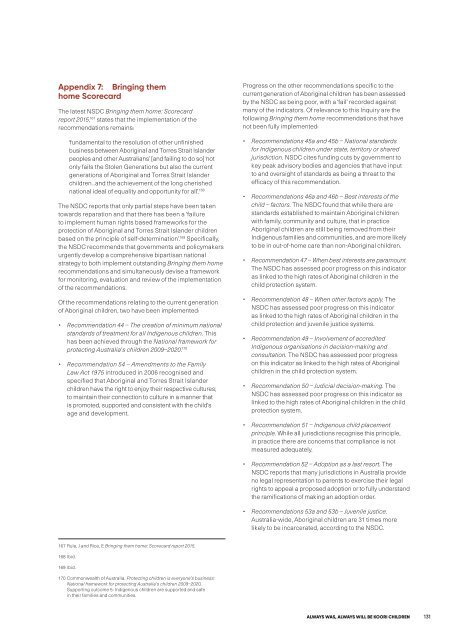ALWAYS WAS ALWAYS WILL BE KOORI CHILDREN
2dHjhRC
2dHjhRC
Create successful ePaper yourself
Turn your PDF publications into a flip-book with our unique Google optimized e-Paper software.
Appendix 7: Bringing them<br />
home Scorecard<br />
The latest NSDC Bringing them home: Scorecard<br />
report 2015, 167 states that the implementation of the<br />
recommendations remains:<br />
‘fundamental to the resolution of other unfinished<br />
business between Aboriginal and Torres Strait Islander<br />
peoples and other Australians’ [and failing to do so] ‘not<br />
only fails the Stolen Generations but also the current<br />
generations of Aboriginal and Torres Strait Islander<br />
children…and the achievement of the long cherished<br />
national ideal of equality and opportunity for all’. 168<br />
The NSDC reports that only partial steps have been taken<br />
towards reparation and that there has been a ‘failure<br />
to implement human rights based frameworks for the<br />
protection of Aboriginal and Torres Strait Islander children<br />
based on the principle of self-determination’. 169 Specifically,<br />
the NSDC recommends that governments and policymakers<br />
urgently develop a comprehensive bipartisan national<br />
strategy to both implement outstanding Bringing them home<br />
recommendations and simultaneously devise a framework<br />
for monitoring, evaluation and review of the implementation<br />
of the recommendations.<br />
Of the recommendations relating to the current generation<br />
of Aboriginal children, two have been implemented:<br />
••<br />
Recommendation 44 – The creation of minimum national<br />
standards of treatment for all Indigenous children. This<br />
has been achieved through the National framework for<br />
protecting Australia’s children 2009–2020. 170<br />
••<br />
Recommendation 54 – Amendments to the Family<br />
Law Act 1975 introduced in 2006 recognised and<br />
specified that Aboriginal and Torres Strait Islander<br />
children have the right to enjoy their respective cultures;<br />
to maintain their connection to culture in a manner that<br />
is promoted, supported and consistent with the child’s<br />
age and development.<br />
Progress on the other recommendations specific to the<br />
current generation of Aboriginal children has been assessed<br />
by the NSDC as being poor, with a ‘fail’ recorded against<br />
many of the indicators. Of relevance to this Inquiry are the<br />
following Bringing them home recommendations that have<br />
not been fully implemented:<br />
••<br />
Recommendations 45a and 45b – National standards<br />
for Indigenous children under state, territory or shared<br />
jurisdiction. NSDC cites funding cuts by government to<br />
key peak advisory bodies and agencies that have input<br />
to and oversight of standards as being a threat to the<br />
efficacy of this recommendation.<br />
••<br />
Recommendations 46a and 46b – Best interests of the<br />
child – factors. The NSDC found that while there are<br />
standards established to maintain Aboriginal children<br />
with family, community and culture, that in practice<br />
Aboriginal children are still being removed from their<br />
Indigenous families and communities, and are more likely<br />
to be in out-of-home care than non-Aboriginal children.<br />
••<br />
Recommendation 47 – When best interests are paramount.<br />
The NSDC has assessed poor progress on this indicator<br />
as linked to the high rates of Aboriginal children in the<br />
child protection system.<br />
••<br />
Recommendation 48 – When other factors apply. The<br />
NSDC has assessed poor progress on this indicator<br />
as linked to the high rates of Aboriginal children in the<br />
child protection and juvenile justice systems.<br />
••<br />
Recommendation 49 – Involvement of accredited<br />
Indigenous organisations in decision-making and<br />
consultation. The NSDC has assessed poor progress<br />
on this indicator as linked to the high rates of Aboriginal<br />
children in the child protection system.<br />
••<br />
Recommendation 50 – Judicial decision-making. The<br />
NSDC has assessed poor progress on this indicator as<br />
linked to the high rates of Aboriginal children in the child<br />
protection system.<br />
••<br />
Recommendation 51 – Indigenous child placement<br />
principle. While all jurisdictions recognise this principle,<br />
in practice there are concerns that compliance is not<br />
measured adequately.<br />
••<br />
Recommendation 52 – Adoption as a last resort. The<br />
NSDC reports that many jurisdictions in Australia provide<br />
no legal representation to parents to exercise their legal<br />
rights to appeal a proposed adoption or to fully understand<br />
the ramifications of making an adoption order.<br />
• • Recommendations 53a and 53b – Juvenile justice.<br />
Australia-wide, Aboriginal children are 31 times more<br />
likely to be incarcerated, according to the NSDC.<br />
167 Rule, J and Rice, E Bringing them home: Scorecard report 2015.<br />
168 Ibid.<br />
169 Ibid.<br />
170 Commonwealth of Australia, Protecting children is everyone’s business:<br />
National framework for protecting Australia’s children 2009–2020,<br />
Supporting outcome 5: Indigenous children are supported and safe<br />
in their families and communities.<br />
<strong>ALWAYS</strong> <strong>WAS</strong>, <strong>ALWAYS</strong> <strong>WILL</strong> <strong>BE</strong> <strong>KOORI</strong> <strong>CHILDREN</strong><br />
131


